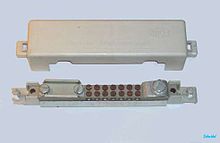Equipotential bonding rail
The equipotential bonding rail is part of the electrical installation and internal lightning protection of a building. It consists of a metal strip on which screw terminals of various sizes are attached. The screw terminals are used to connect earthing and protective lines indoors. The equipotential bonding rail places all metal structures and facilities of a building connected to one another via it, as well as the foundation earth electrode, on a common earth potential .
The building facilities usually connected to the equipotential bonding rail include:
- Earth electrode (system), especially the foundation earth electrode
- Protective conductor of the electrical installation
- the equipotential bonding conductor at the HÜP ( house transfer point ) of the cable television
- Distribution cabinets of the communication infrastructure and possibly the telephone system
- PE connection of surge arresters
- the lightning protection system
- all metallic structural parts, such as
- Heating, water and gas pipes
- Tank pipelines (via spark gap )
- Antenna system
- Elevator system
- Handrails and railings of metal
The inclusion of metal bathtubs and shower trays in the equipotential bonding is no longer required. Instead, an additional equipotential bonding must be created that includes all conductive pipe systems close to where the lines enter the bathroom.
With the exception of the earthing system, the protective conductor and the lightning protection system, the connections are usually made with copper conductors with a minimum cross-section of 2.5 mm² for mechanically protected or 4 mm² for unprotected installation.
Norms
- DIN VDE 0618 Part 1: Potential equalization rail (PAS) for the main potential equalization.
literature
- Winfrid Hauke, Rolf Thaele, Günter Reck: RWE Energie Bau-Handbuch. 12th edition, Energie-Verlag GmbH, Heidelberg, 1998, ISBN 3-87200-700-9
- Alfred Hösl, Roland Ayx, Hans Werner Busch: The electrical installation in accordance with regulations, residential construction, commercial industry. 18th edition, Hüthig Verlag, Heidelberg, 2003, ISBN 3-7785-2909-9

